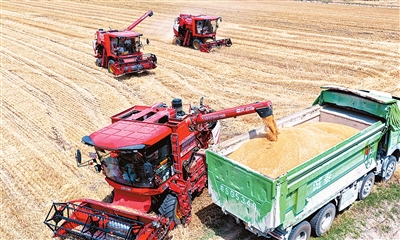




- BRNN
- BRI News
- BRNN News
- Database
Official Documents Polices and Regulations
Inter-government Documents International Cooperation BRI Countries
Business Guide Economic Data BRI Data
Trade
Investment Projects Latest projects
Cases - Content Pool
China's summer wheat harvest is now in full swing across major producing regions.
According to the Ministry of Agriculture and Rural Affairs (MARA), more than 17 million pieces of agricultural machinery will be deployed nationwide to ensure smooth harvesting, sowing and field management, including over 800,000 combine harvesters, with more than 200,000 working across regions.

A combine harvester is seen at wheat fields in Hehui village, Nanshahe town, Tengzhou city, east China's Shandong Province. (Xinhua/Li Zhijun)
The summer harvest season in China typically runs from mid-May to June, with most activity focused on reaping winter wheat, a staple crop.
Central China's Henan Province, which produces nearly a quarter of the nation's wheat, has more than 85 million mu (5.67 million hectares) of wheat ready for harvest. Across the province, farmers are racing against time to bring in the crop.
In Poyu village, Suiping county, Zhumadian city, combine harvesters are busy reaping wheat, with grain loaded directly onto trucks for transport.
"The wheat ripened early, about 10 days ahead of schedule," said Wang Fuping, a major grain grower who is overseeing operations on his 5,000-mu wheat farm.
Zhumadian has deployed 35,000 harvesters this season to work its nearly 12 million mu of wheat.
Data from the Henan provincial department of agriculture and rural affairs show that as of 5 p.m. on June 1, the province had harvested 57.46 million mu of wheat, accounting for about 67.5 percent of the total planted area.
In Anhui Province, another major wheat-producing region in eastern China, more than 43 million mu of wheat was planted this year, and the harvest is picking up pace.
In Huoqiu county, Lu'an city, officials plan to deploy 5,500 combine harvesters to complete the harvest of 1.7 million mu of wheat within 10 days.
Anhui expects to finish the wheat harvest by June 10, with a mechanization rate exceeding 98.5 percent.

A combine harvester loads wheat in Shuanglou village, Zhaoqiao township, Qiaocheng district, Bozhou city, east China's Anhui Province. (Photo/Liu Qinli)
According to the latest survey by the MARA, as of 5 p.m. on May 30, China had harvested 129 million mu of wheat, with progress surpassing 30 percent.
"The planting area of winter wheat remained stable at 350 million mu this year, showing modest growth," said Liu Luxiang, head of the wheat industry expert team at the Chinese Academy of Agricultural Sciences.
Driving the accelerated wheat harvest is increased investment in smart agricultural machinery and the use of new technologies and equipment.
In Zhongxiang city, central China's Hubei Province, combine harvesters equipped with the BeiDou satellite navigation system have become the backbone of the harvest season.
"These intelligent harvesters can efficiently complete the entire process — from harvesting to threshing — with wheat directly loaded onto trucks and transported to agricultural service centers for drying," said Tian Jun, a local grain farmer.
Tian added that 500 mu of wheat were harvested in just a day and a half, improving operational efficiency by 30 percent.
This year, the winter wheat planting area in Hubei Province exceeded 15 million mu, with more than 60,000 BeiDou-enabled intelligent terminals installed on agricultural machinery — ranking among the top nationwide in application scale.
Thanks to smart agricultural machinery, Hubei completed its large-scale wheat harvest in just 17 days this year, a 19 percent reduction compared to 21 days in 2024.
Many agricultural machinery operators involved in cross-regional mechanized harvesting have adopted AI-powered apps that analyze wheat planting data, growth conditions and maturity levels. These apps predict optimal harvest times using historical and real-time data, providing guidance for efficient cross-regional harvesting.
In east China's Shandong Province, the second-largest wheat-producing province, efforts are underway to harvest over 60 million mu of wheat while simultaneously advancing corn and soybean sowing.
"As soon as the wheat is harvested, planters are deployed immediately to seize the optimal time for seeding," said Xu Baizhen, deputy Party chief of Kangzhuang town in Linqing city, Shandong Province.
In recent years, the town has actively promoted soybean-corn strip intercropping. This year, it continues to prioritize large-scale farming, working closely with major growers, family farms, farming cooperatives and other agricultural entities to improve productivity.
As one of China's key summer corn production areas, Shandong has prioritized soybean capacity enhancement in its agricultural development strategy in recent years, according to a provincial official.
Shandong will stabilize planting areas, enhance soybean output, and strengthen support in agricultural supplies, water access, equipment, and meteorological services, laying a solid foundation for a strong autumn grain harvest, according to a local official.
To support national efforts in crop pest and disease control, the Ministry of Finance and the MARA recently allocated 1.4 billion yuan ($194.33 million) in central government funds for disaster prevention and relief to boost agricultural production.

Tel:86-10-65363107, 86-10-65368220, 86-10-65363106